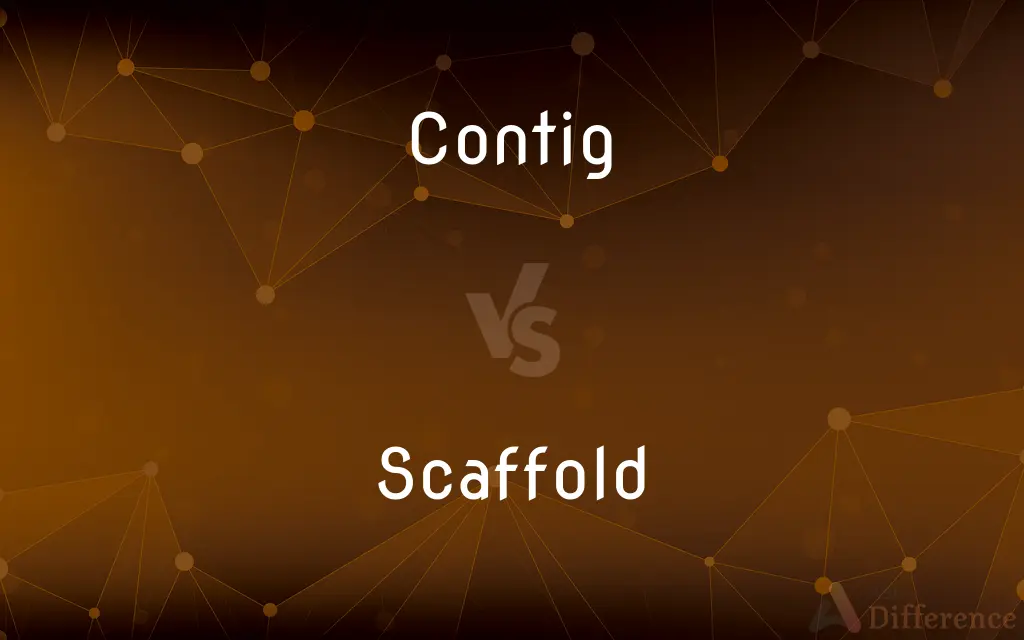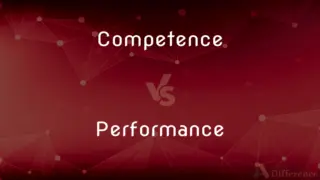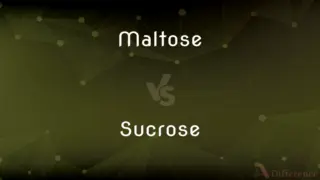Contig vs. Scaffold — What's the Difference?
Edited by Tayyaba Rehman — By Maham Liaqat — Updated on March 15, 2024
A contig is a set of overlapping DNA segments that together represent a consensus region of DNA, whereas a scaffold includes contigs separated by gaps, providing a broader view of a genome's structure.

Difference Between Contig and Scaffold
Table of Contents
ADVERTISEMENT
Key Differences
Contigs are formed by aligning and merging overlapping DNA sequences obtained from genome sequencing projects, creating a continuous sequence that represents a portion of the chromosome. Whereas scaffolds are more complex structures that include contigs linked together by known distances, but still contain gaps that represent unsequenced parts of the genome.
The assembly of contigs is a critical step in the genome sequencing process, providing the basis for reconstructing the genome. On the other hand, scaffolds are used to extend this assembly by connecting contigs with known sequences of gaps, which may later be filled with additional sequencing to complete the genome.
Contig assembly relies heavily on the quality and quantity of sequencing data, with higher accuracy and coverage leading to longer contigs. In contrast, scaffold assembly not only depends on contig information but also on additional data like mate pairs or bridge sequences that help to order and orient the contigs within the scaffold.
The primary goal of creating contigs is to accurately piece together the sequences of DNA that directly overlap, minimizing errors and gaps. Whereas the goal of scaffolding is to provide a broader overview of the genome's structure, indicating how contigs relate to each other spatially within the chromosome.
In terms of utility, contigs are often used for detailed study of specific genomic regions, such as identifying genes or mutations within a small area. Scaffolds, however, are crucial for understanding the higher-order organization of the genome, such as the arrangement of genes and regulatory elements across entire chromosomes.
ADVERTISEMENT
Comparison Chart
Definition
A continuous sequence of DNA created by assembling overlapping sequences.
A structure in genome assembly that organizes contigs with gaps between them.
Composition
Overlapping DNA sequences merged into a consensus region.
Contigs linked by non-sequenced gaps, known distances.
Purpose
To accurately reconstruct a specific region of the genome.
To provide an overview of genome structure, including the arrangement of contigs.
Dependency
Quality and coverage of sequencing data.
Contig information and additional data like mate pairs.
Utility
Detailed study of genomic regions, identifying genes or mutations.
Understanding the higher-order organization of the genome.
Compare with Definitions
Contig
A contiguous sequence of DNA assembled from overlapping fragments.
They analyzed the contig to pinpoint the mutation responsible for the disease.
Scaffold
A structure in genome assembly that extends beyond contigs by including gaps.
Scaffolds are crucial for bridging the gaps in the genome sequence.
Contig
A basic unit of genome assembly reflecting a continuous genomic region.
Researchers used the contig to study gene expression patterns.
Scaffold
An assembly that organizes contigs with known gaps between them.
The scaffold provided a preliminary view of the genome's architecture.
Contig
The product of assembling sequencing reads into longer sequences.
The sequencing project aimed to extend the length of their contigs.
Scaffold
A genomic map including contigs and gaps, offering a broader genome perspective.
The scaffold revealed the spatial relationship between different genomic regions.
Contig
The result of merging overlapping DNA sequences to form a longer sequence.
The contig represented a significant portion of the chromosome.
Scaffold
A higher-order structure connecting contigs to represent chromosome organization.
Using scaffolds, they identified the arrangement of several key genes.
Contig
A sequence without gaps, assembled from DNA fragments.
The contig was essential for accurate gene mapping.
Scaffold
A framework used in genome assembly to place contigs in a correct order and orientation.
The new scaffolding technique significantly improved the genome assembly.
Contig
A contig (from contiguous) is a set of overlapping DNA segments that together represent a consensus region of DNA. In bottom-up sequencing projects, a contig refers to overlapping sequence data (reads); in top-down sequencing projects, contig refers to the overlapping clones that form a physical map of the genome that is used to guide sequencing and assembly. Contigs can thus refer both to overlapping DNA sequence and to overlapping physical segments (fragments) contained in clones depending on the context.
Scaffold
A temporary platform, either supported from below or suspended from above, on which workers sit or stand when performing tasks at heights above the ground.
Contig
(genetics) A set of overlapping DNA segments, derived from a single source of genetic material, from which the complete sequence may be deduced.
Scaffold
A raised wooden framework or platform.
Scaffold
A platform used in the execution of condemned prisoners, as by hanging or beheading.
Scaffold
To provide or support with a raised framework or platform.
Scaffold
To place on a raised framework or platform.
Scaffold
A structure made of scaffolding for workers to stand on while working on a building.
Scaffold
An elevated platform on which a criminal is executed. Category:en:Capital punishment
Scaffold
(metalworking) An accumulation of adherent, partly fused material forming a shelf or dome-shaped obstruction above the tuyeres in a blast furnace.
Scaffold
(sciences) A structure that provides support for some other material.
Scaffold
(transitive) To set up a scaffolding; to surround a building with scaffolding.
Scaffold
(transitive) To sustain; to provide support for.
Scaffold
A temporary structure of timber, boards, etc., for various purposes, as for supporting workmen and materials in building, for exhibiting a spectacle upon, for holding the spectators at a show, etc.
Pardon, gentles all,The flat, unraised spirits that have daredOn this unworthy scaffold to bring forthSo great an object.
Scaffold
Specifically, a stage or elevated platform for the execution of a criminal; as, to die on the scaffold.
That a scaffold of execution should grow a scaffold of coronation.
Scaffold
An accumulation of adherent, partly fused material forming a shelf, or dome-shaped obstruction, above the tuyères in a blast furnace.
Scaffold
To furnish or uphold with a scaffold.
Scaffold
A platform from which criminals are executed (hanged or beheaded)
Scaffold
A temporary arrangement erected around a building for convenience of workers
Scaffold
Provide with a scaffold for support;
Scaffold the building before painting it
Common Curiosities
What distinguishes a contig from a scaffold in genome sequencing?
A contig is a continuous sequence of DNA, while a scaffold includes contigs and gaps, providing a broader genomic structure.
What role do mate pairs play in scaffold assembly?
Mate pairs provide information on the distance and orientation between contigs within scaffolds.
How are contigs created?
By aligning and merging overlapping DNA sequences obtained from sequencing projects.
How do contigs contribute to genome mapping?
They are used for detailed analysis of specific genomic regions, like identifying genes or mutations.
Can scaffolds have gaps?
Yes, scaffolds contain gaps that represent unsequenced parts of the genome.
What are the challenges in transitioning from contigs to scaffolds?
Bridging the gaps between contigs with accurate distance and orientation information is a major challenge.
Why are scaffolds important in genome assembly?
They help in understanding the higher-order organization of the genome, showing how contigs are arranged within chromosomes.
Are contigs or scaffolds more important for identifying genetic mutations?
Contigs are typically more important for pinpointing specific mutations within a genome.
What advancements have improved scaffold assembly?
New sequencing technologies and computational methods have enhanced the accuracy and efficiency of scaffold assembly.
Is it possible to have a complete genome assembly with only contigs?
A complete genome assembly typically requires both contigs and scaffolds to accurately represent the entire genome.
How does the quality of sequencing data affect contig assembly?
Higher accuracy and coverage of sequencing data lead to longer and more reliable contigs.
What's the difference in utility between contigs and scaffolds?
Contigs are used for detailed genomic studies, while scaffolds are essential for understanding the genome's overall structure.
Why might a genome assembly project choose to focus on contig assembly initially?
Focusing on contig assembly allows researchers to accurately piece together smaller regions of the genome, which is a crucial step before scaffold assembly.
Can the gaps in scaffolds be filled?
Yes, gaps can later be filled with additional sequencing efforts to complete the genome assembly.
How do researchers use scaffolds in genetic studies?
They use scaffolds to explore the spatial relationships between genes and regulatory elements across chromosomes.
Share Your Discovery

Previous Comparison
Competence vs. Performance
Next Comparison
Maltose vs. SucroseAuthor Spotlight
Written by
Maham LiaqatEdited by
Tayyaba RehmanTayyaba Rehman is a distinguished writer, currently serving as a primary contributor to askdifference.com. As a researcher in semantics and etymology, Tayyaba's passion for the complexity of languages and their distinctions has found a perfect home on the platform. Tayyaba delves into the intricacies of language, distinguishing between commonly confused words and phrases, thereby providing clarity for readers worldwide.
















































